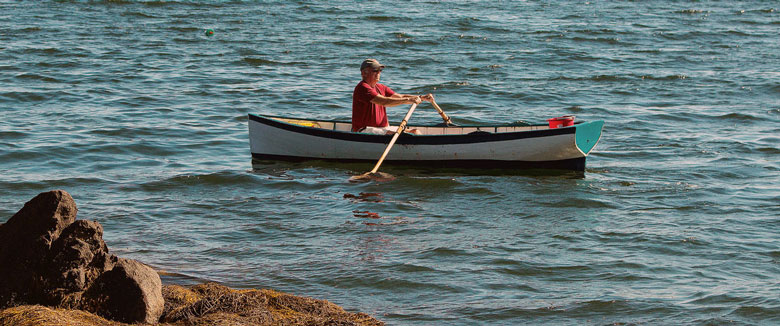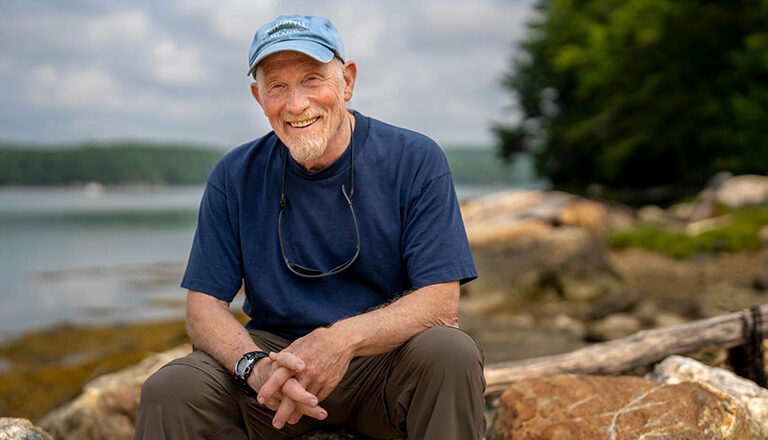I’m just back from an hour’s row on a day that I think may be the first of summer. Clearly I’m hedging here, having experienced the spring, which started and stopped too many times to count.
But it’s June 1, the sky’s clear and the sun’s out, the wind’s not too strong, and the rowing conditions are right. I left at high tide, which on the coastal river where we live is about the only time for serious rowing.
I’ve been a rower since I was a kid lots of years ago. Over the years I’ve tried rowboats old and new, long and short, wood and fiberglass, even something aluminum designed for an outboard and definitely not for oars.
I’ve rowed with seven other people and a coxswain in a shell with outriggers and sliding seats; I’ve rowed in a single, set up the same way. These days, after trying just about every kind of oar-powered boat I can think of, I’m really back to basics: a fiberglass 13-footer built 40 or 50 years ago by Jarvis Newman of Southwest Harbor. It has two rowing stations, two sets of oarlocks, fixed seats, built-in floatation.
Rowing appeals to me because I like history and knowing where I’ve been.
I got this boat from Camp Ketcha near our home, where I found it languishing beside a barn in the snow, needing new gunwales and repairs to one of the seats.
“I’ve had to keep moving it out of the way of the snowplow,” the camp director told me, indicating I’d be doing him a favor if I took the boat away. I did so; no money changed hands, but I did make a donation to the camp, which presumably had received the boat as a donation it really didn’t need.
A free boat in my case, more or less, and all I had to do was fix the gunwales and seat, plus a paint job. And oh, yes, I had to make a pair of oars, which turned out to be a welcome and fun shop project during that first winter of COVID.
When spring came that year I moored the boat on a running line out front, named it Right Now after my wife’s legendary impatience for the doneness of projects, and went rowing when things were right.
As I’ve explained, conditions here are right when we’re close to high tide. Once things are right, I have a choice, which is easy: before high tide when the water’s still flowing into the river, I head out into the salt water (Saco Bay); after high tide when the water’s going the other way I head upstream. Either way, if I time it right, I row against the current when I’m feeling strong, then ride the current home after I’m tired.
Rowing, I’ve told friends who prefer canoes and kayaks and are accustomed to looking ahead instead of astern, appeals to me because I like history and knowing where I’ve been. My boat’s wake (plus the little mirror I have on my cap) keep my course true, and where my back and leg muscles are concerned, pulling feels a lot better than pushing. The oarsman’s stroke—even mine at an advanced age—is powerful and smooth; I like to think of it as like the rowers in an eight-person shell. In the right boat I can really get going, even against the tidal current.
“Are you going to row all winter?” a neighbor asked me a couple of years ago when she noticed me out there in November. I’d thought of it, I replied, but I probably wouldn’t be out there dodging ice cakes or freezing my hands when things got really cold. But for three years now I’ve kept the boat in the water until nearly Thanksgiving, hauled it for the snowier months (remember them?) and then headed back out around the first of May.
This year I didn’t set the mooring out until June 1 for various reasons, including repeated storms and time away. Even so I did quite a bit of cold-weather rowing, but now it finally feels like summer. Climate change has to have been a factor; it has certainly affected natural systems like storms, water levels, and the tides that so strongly influence where and when I row my boat.
I get only a few hours of prime rowing conditions here on the river—not much more than two hours either side of high. But when it’s right and off I go, I’m continuing to learn about the currents, shallows, depths, and other riverine things that make my rowing so interesting.
Out in the bay these factors take a back seat to others—waves, fog, wind, seabirds, jumping fish, lobster buoys, other boats—that keep me focused as I pull my way through the miles. Along the way, upstream or down, I use a GPS tracker to “map my row” and keep track of my time.
To sum up, rowing has always been one of my favorite activities; great exercise when the tide’s right and I make myself get going; a Zen-like way to remind me what’s really going on in the world.
David D. Platt is a former editor of The Working Waterfront.





